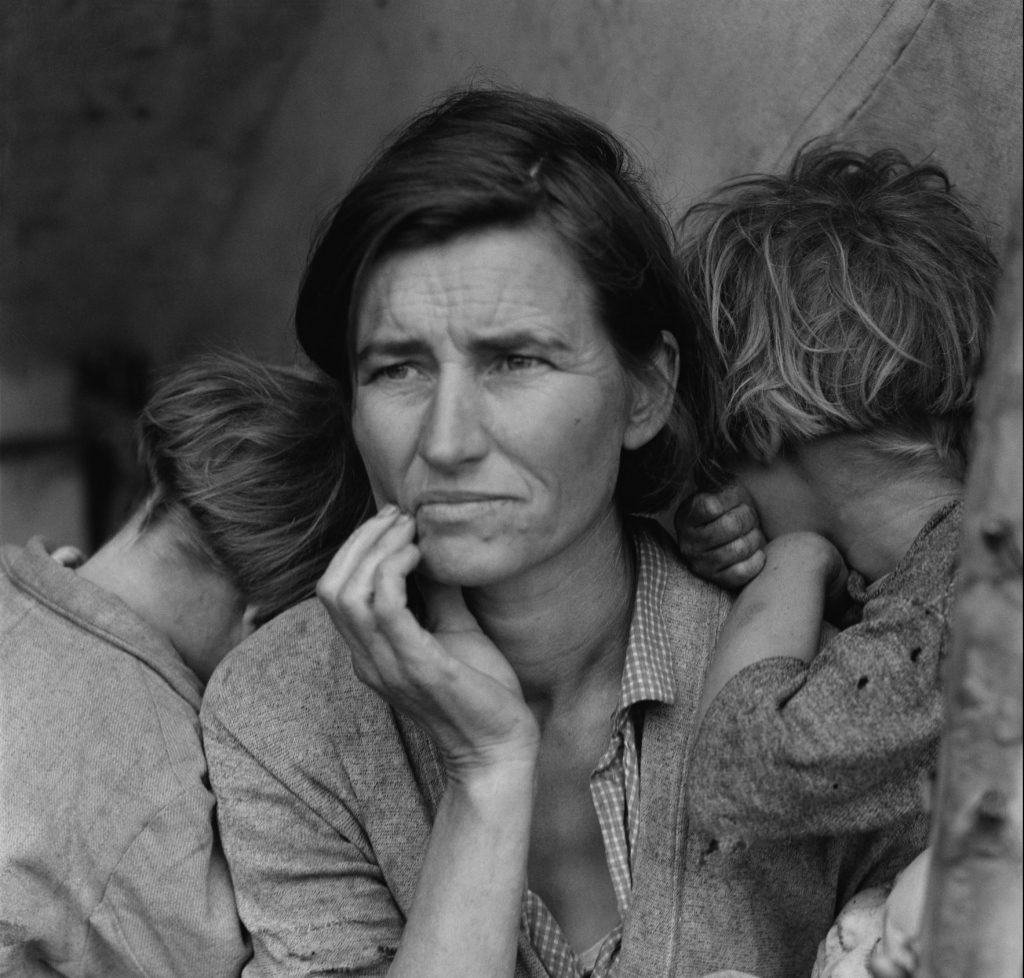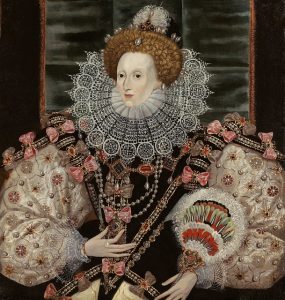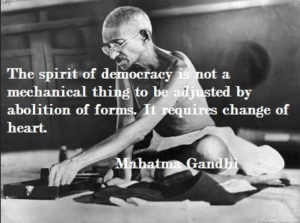What can a single image possibly say about our complex world? Of course, one picture can’t possibly capture everything. All of the tragedy and despair or all of the celebrations and joyful moments can hardly be captured in a million pictures. So, what difference can one picture really make? Documentary photographer, Dorothea Lange, set out with a simple goal in mind: to document the lives of the ordinary people in the world around her. In doing so, she inadvertently brought about drastic change through the increase of awareness of poverty and the conditions people were forced to endure. Lange influenced millions through the use of one single picture, and, that influence has and will continue for decades in the future.1
Lange found her life’s work and passion as a photographer in the 1930s, following the path of a common photographer in capturing people’s portraits and selling them to make a profit. While she enjoyed her work and was obviously very skilled, she always thought of herself as more of a historian than a true artist. As her career in portraiture continued, she improved her skills and came to open up a studio of her own in San Francisco, California. Here, she continued to perfect her craft, and she shared her talent with those among the wealthier classes of her society. It didn’t take long, however, for her to realize that her picture-taking skills could be used for much bigger, much greater, and overall, much more important things.2
In the midst of her successful portrait-focused career, the Great Depression struck and ravaged the lives of Americans far and wide. Lange, who originally, “would have thought it enough to take a picture of a man, nothing more,” quickly came to readjust her mindset upon seeing the pain in the world around her, and instead, decided that she “wanted to take a picture of a man as he stood in the world.”3 In 1933, a time in American history categorized by increasing tension and unbearable poverty in the lives of the average worker, Lange made what would come to be a life-changing decision: a drastic change in her creative mindset from elegant portraits to exposing the conditions of poverty. This single change in her life led her to become, undoubtedly, one of the most influential documentary photographers of the Great Depression.4

In May of 1935, with her newfound purpose of documenting the suffering around her, Lange became an employee of the Resettlement Administration (RA), later known as the Farm Security Administration (FSA). The goal of the RA was to bring to light the struggles of rural poverty in the country through the use of photographs. They found that sharing the conditions and hardships of life through photographs was much more impactful than any written reports, because the audience could see situations with their own eyes, which they may not have ever had the chance to see. The RA used this method of documentary photography because they recognized how powerful it could be and they needed to gain support for their projects. Lange’s job with the RA was demanding and required her to travel across the country to places that many had never heard of or even knew existed at all.5 Needless to say, she completed meaningful work and had many adventures throughout her time with the RA.

On one such adventure, on a rainy day in March of 1936, Lange had just finished another one of her photography excursions in California, and had packed up all of her equipment and supplies to begin her more than seven-hour drive home to her family. The drive started off dull and uneventful as she pushed ahead in the pouring rain. Occasionally, there were other cars and signs on the side of the road, but nothing out of the ordinary for the small San Luis Obispo County road. “PEA-PICKERS CAMP” one sign read. She considered stopping, thinking she would document more of the harsh conditions in the rural area, but instead, decided against it, knowing she still had a long trip ahead of her. While the sign and the camp became further and further behind her, they never left the forefront of her mind.
As she drove on, she thought to herself, questioning what could have been so special about that camp. It was just another pea-pickers camp, like the others she had already seen and taken pictures of. Why should she care about another one? It couldn’t possibly be that different from the ones she’d already seen. She would probably just drive in to find the same suffering and poverty she’d seen at the others. What difference would it make if she just drove past this one camp? Nobody even knew it existed anyway, so it wouldn’t make a difference, right? After getting lost in this inner argument, trying in every way possible to convince herself why she should not turn around, Lange almost unconsciously made a U-turn twenty miles past the sign and began to drive back to the camp.6
Upon reaching the camp that she had almost convinced herself to leave behind, Lange was drawn to one woman in particular. She didn’t ask for the woman’s name, or anything about her history or how she came to work at the pea-picker camp. Lange simply saw this kind of information as irrelevant to achieving her goal, which was to highlight the horrendous conditions and intense poverty of the Great Depression. While she didn’t learn much about the woman, she did learn that she was a mother of seven, living in a makeshift tent surviving mostly on frozen vegetables and small birds. The woman and Lange talked briefly, and then Lange proceeded to take a total of five pictures of the mother and several of her children, later saying, “There she sat in that lean-to tent with her children huddled around her, and seemed to know that my pictures might help her, and so she helped me. There was a sort of equality about it.” After spending a brief ten minutes at the camp, with the limited amount of information Lange had on her subjects, and a grand total of five pictures, Lange once again packed up her supplies and continued on her long trip back home.7

Lange’s intuition to turn her car around that day must have been very powerful. Deep down inside she must have known that her choice to go on or to turn around would make a profound difference in her story and in the lives of millions of those struggling around the world. That one, ten minute stop and those five pictures that Lange almost didn’t get the chance to take, later came to shape her entire career. Those pictures are the reason she is remembered to this day, the most famous being titled “Migrant Mother.” This image depicts the mother of seven that Lange met at the pea-picker camp, staring far off into the distance, seemingly lost in thought and isolated, even as she was surrounded by several of her children. Most, if not all, of Lange’s pictures had a recurring theme of separation from society, with an emphasis on the struggling classes and the pain that they had to endure on a daily basis.8 Lange’s “Migrant Mother,” however, displayed this theme so well that it became a symbol of the Great Depression as a whole. The image became an icon of the Great Depression and people in different cultures even began to replicate it to make it relevant to themselves. One picture gave the mother and children Spanish features, while still another gave them black features.9 Her work was so moving that it mirrored the isolated feelings of numerous cultures and became universally accepted and used to try and changed the way these people were being treated. Lange’s “Migrant Mother” slowly became one of the most recognizable and copied images in history.10
- Encyclopedia of the Great Depression, 2004, s.v. “Lange, Dorothea,” by Linda Gordon. ↵
- Allison McNeill et al., Great Depression and New Deal Biographies (Great Depression and the New Deal Reference Library: vol. 2: Biographies, UXL, 2003), 141-142. ↵
- David P. Peeler, Hope among Us Yet: Social Criticism and Social Solace in Depression America (Athens, Georgia: University of Georgia Press, 1987), 62. ↵
- Encyclopedia of the Great Depression, 2004, s.v. “Lange, Dorothea,” by Ed. Robert S. McElvaine. ↵
- Allison McNeill et al., Great Depression and New Deal Biographies, (Great Depression and the New Deal Reference Library: vol. 2: Biographies, UXL, 2003), 144-146. ↵
- Milton Meltzer, Dorothea Lange: A Photographer’s Life (New York, NY: Farrat, Straus & Giroux, 1978), 132-133. ↵
- Dorothea Lange, “The Assignment I’ll Never Forget: Migrant Mother,” Popular Photography February 1960, 1-2. ↵
- Melissa A. McEuen, Seeing America: Women Photographers between the Wars (Kentucky: The University Press of Kentucky, 2000), 110. ↵
- Judith Fryer Davidov, Women’s Camera Work: Self/Body/Other in American Visual Culture. (Durham, North Carolina: Duke University Press, 1998), 5-6. ↵
- Lawrence W. Levine, “The Historian and the Icon: Photography and the History of the American People in the 1930s and 1940s,” In Documenting America, 1935–1943, (Berkley: University of California Press, 1988), 16. ↵



140 comments
Kaitlyn Killebrew
In all honesty I have seen these pictures but never really knew the context in which they were taken. We didn’t go into great detail about the Great Depression in high school so the term “pea-picking camp” was not a something I had been affiliated with before. What I found most strange is that she went back to this particular camp in the first place. She had even said that she had gone to numerous camps and was going to ignore this one, yet she turned around. I don’t think she could have predicted the outcomes of taking that U-turn.
Angel Torres
The saying, “a picture is worth a thousand words,” really sums up the article on Dorothea Lange. The fact that one simple photograph can describe such a complex idea or situation is amazing. Lange’s decision to go from capturing portraits of those more affluent in society, to capturing moments of people that have been greatly impacted by the Great Depression was interesting. Many people would not have been able to make the decision she made. The article provided a good insight into Lange’s work of capturing individuals and key moments during the Great Depression.
Avery Looney
This article was very well written and researched. The photos taken by Dorothea Lange are absolutely beautiful and they highlight the struggles faced by normal people. The photos she took of the migrant mother in California illustrate the daily struggles that her and her family face daily. Lange was a true artist and she made even the most basic of pictures absolutely breathtaking and have a story behind them.
Megan Copeland
I remember studying this picture all throughout middle school and high school. I believe this picture represented the Great Depression perfectly. It shows a mother who is clearly at a loss for words and does not know what to do. She looks so sad and the picture helps us see what it was truly like for those people during the Great Depression. I think this was a very good article, and the pictures you picked for it were great.
Irene Astran
I appreciate that Lange took the initiative to shed light on the poverty plaguing the country at the time. As Marianists we are often encouraged to be the voice for those in poverty. I believe Lange’s work was representative of that. It is hard for people to really grasp the despair brought during that time if they were not exposed to it.
Sienna Guerra
This is a picture that I have been introduced too many times and first looking at it is powerful and captures moments that even the naked eye has a hard time capturing.This article both helped me learn and understand how Lange was a true artist and had a talent so beautiful. Congrats on publishing this article and being nominated for best use of images!
Daniela Cardona
I have talked about this picture before in a previous art class and it again goes to show just how important art is. It tells a story and it calls for an emotional response just by being. It captures a perfect moment, one that is fleeting but important. This one picture speaks for a time period and it does so very well. This picture forces attention to the bad side of history we usually try to turn our backs on, the side that makes the country look bad. It is justice for the past and a warning for the future.
Kathyleen Lauriano
I had seen this picture and talk about it in my art class many times, but not in depth to where I understood its meaning. This article did great in explaining some of the images and the stories behind them, even if they weren’t the happiest. Not a lot of photographers have such a good talent at capturing moments that could speak for themselves. Great article!
Annissa Noblejas
Like many others, I had seen this picture without knowing the full story behind it. But the woman pictured seemed to come to life with a full spectrum of emotion captured in this one photograph. As a mother I could not imagine the daily struggle this woman must have endured just to provide and care for her children. History tends to skip over the poor and desolate, but Dorothea Lange changed that by capturing the real life struggles so many faced during this time in American history.
Crystal Baeza
I’ve read a few articles about Lange and find her pictures captivating. The title speaks for what her images were able to show many went though during the Great Depression. Even though the article talked about the obstacles people faced during this time and the stories behind the images weren’t the sweetest, the images itself were one a kind. Not many photographers have the ability to capture moments and have them speak for itself. Lange was truly an artist and knew she had a beautiful talent.